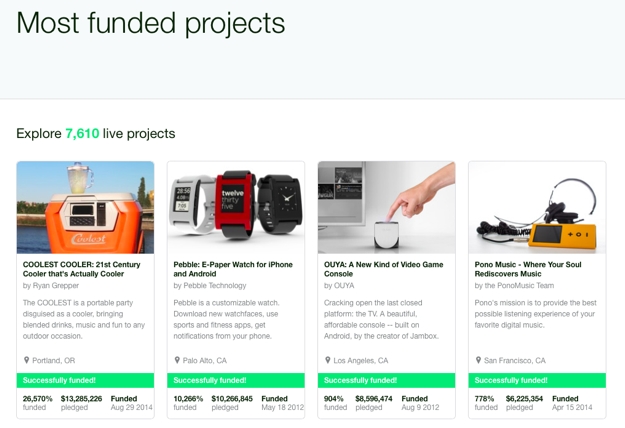Five Tips to Fuel Your Next Launch From the Coolest Cooler's Record-Shattering Kickstarter Campaign
September 2014
By Jeremy Girard

62,64 backers. $13,285,226 dollars. 26,570% of the fundraising goal met.
By any count, these are staggering figures – even more so when you discover that they all pertain to a cooler. Specifically, we’re talking about inventor Ryan Grepper’s
Coolest Cooler, a high-tech party-on-wheels that boasts fun-inducing features such as a built-in blender, speakers, USB charger and much more. It has also surpassed other headline-grabbing Kickstarter campaigns, including the Pebble smartwatch and the Veronica Mars Movie Project, to become the site’s most funded campaign ever.

Perhaps the most surprising fact about this record-smashing campaign, however, is that Grepper’s first attempt at funding the Coolest Cooler through Kickstarter failed less than 12 months ago.
So what were the sparks that set the second campaign ablaze? And how can you apply these lessons to ignite your next marketing campaign or product launch? Let’s take a look:
What was different this time around?
Before we look at the exact lessons that this campaign can teach us, it is helpful to consider what was done differently on this second, wildly successful campaign versus the first one which did not meet its funding goal.
- The campaign was launched during the summer months, rather than the winter.
- The design of the Coolest was revamped and updated.
- The funding goal was lowered.
In addition to these changes, the second campaign also benefited from supporters who backed the idea the first time around. That first campaign fell short of its goal of $125,000, but it did generate $102,188 in pledges from 279 supporters – and those supporters were first in line when the second campaign launched.
So what lessons do these changes, and the success resulting from those changes, teach us?
1. Timing is key.
The first time this campaign was run, it was in December. This time, it was done in the summer, when trips to the beach and having an amazing cooler are much more in people’s minds. As the Coolest’s inventor told Geekwire in a recent interview, “launching a product when backers are most likely to be receptive makes a difference.”
This same principal holds true for any marketing campaign. You need to launch your campaign when the time is right. For instance, take the week of Thanksgiving. The company that I work for does no marketing pushes during that week. This is because we are a B2B company, and the customers we work with are either off during the week of the Thanksgiving holiday or, if they are in the office, their mind is certainly not on making new business technology decisions or purchases. For a B2B company, this holiday week is not good timing for a campaign.
If, however, you are a B2C business, this week is golden! The day after Thanksgiving, commonly known as Black Friday, is one of the biggest shopping days of the year, followed a few days later by the similarly popular Cyber Monday. This entire holiday weekend is filled with ads and promotions for B2C companies, because their customers are in the mindset to buy during that time.
Timing is important, and the exact timing that will work for you may be different than what will work for other companies. You need to think about your audience and what their mindset is and you need to consider your product and whether or not there is a specific time when it will most resonate with potential buyers. You likely even have some offerings that make sense at certain parts of the year and others that are most suited to different time periods. Kicking off a campaign at the right time can be the different between success and failure, as shown in the two different campaigns for the Coolest Cooler.
2. Design matters.
Another change that was made to the Coolest for this second campaign was the product’s design. The new design is much more vibrant and exciting than the first. With sleeker lines and a bold, orange color that really stands out, as well as better integration of the component parts, the improvements to the design of this product played an important role in the amazing success that it has seen on this second go around.
Design is important; yet it is often one of the first things to be compromised on when budgets are being reviewed. Using pre-built templates as opposed to hiring a design professional to craft a look and feel unique to your needs and ideas is an option that too many companies bypass in order to save some money, but as we have seen with the Coolest, design absolutely matters.
Skimping on design is the same as skimping on success. If you are going to launch a campaign, do it right and give it the best chance to succeed by investing in design.
3. Set a realistic bar for success.
Whenever you initiate any kind of marketing or sales campaign, you will have a goal that you are trying to achieve. If you are promoting an event, you will have a certain number of attendees you hope to attract. If you are selling a product, you will have a set number of units you may seek to move. In the case of Kickstarter, there is a “funding goal” that is trying to be reached. While the Coolest’s first campaign came close to that funding goal, the organizers of this campaign decided to drastically lower their goal on the second go-around, from $125,000 to $50,000.
For crowdfunded campaigns, there is wisdom in having a lower threshold for success. Backers are often more likely to contribute to a project if it is close to meeting its goal or if it has already met that goal, which guarantees that the project will move forward. The backers who pledge to a project that does not meet its goal are not charged their pledge amount, so it is not like they are out any money if a campaign fails, but people who back a crowd funded campaign are likely to be excited about that campaign and the “rewards” that their pledge will bring them. If they know that the success of a campaign is all but guaranteed, they are apt to jump in and join the fun instead of waiting by to see what happens. By lowering your threshold for success, you actually encourage people to contribute earlier in the campaign!
In business, having a realistic measurement for success means that a campaign can be seen as positive – and if a campaign yields positive results, it is more likely that you will be able to do other campaigns in the future! On the flip side, if you are unrealistic in your goals for what a campaign will produce, you will be disappointed when the results fall shy of what you were aiming for, even if the numbers you end up with are totally respectable. Set a realistic bar for success and give yourself the momentum to kick off future campaigns that can build on that success!
4. Passionate customers are like gold.
When the second campaign for the Coolest was kicked off, it already had a few hundred passionate supporters – those who had supported the first campaign. These backers helped spread the word on the Coolest, and coupled with the lower funding goal, positive results were seen very quickly (the funding goal was reached in less than 36 hours)! The passion of those initial backers was contagious, and once the campaign started rolling, the success was amazing, and it all started with help from some passionate and vocal supporters.
Having customers who are passionate about your company is one of the best ways to help spread the word on what you have to offer. You can promote your offerings on social media as much as you want, but it often just comes across as a company pitching their products. When a person who is not connected to your company does this, it is received very differently.
Customers who love your company and evangelize to others in their social circles hold weight with their connections that you do not possess. If a company says that they have “the best prime rib in the state”, that is seen as marketing copy, but if a friend of yours updates from a restaurant that they “just has the best steak I’ve ever had!”, you view that message much differently. It is not seen as marketing, it is seen as a recommendation from a trusted source, a friend whose opinion you may value. While the marketing speak may not get you to try that restaurant, your friend’s recommendation likely will. This is why passionate customers are like gold. They will help spread the word on your business to people who trust them. In turn, you then have the chance to “wow” new customers and create new referral sources that can result in amazing business success, just like what we see with the Coolest campaign.
5. Ask for help.
The final item we will point out actually happens at the end of the video introducing the Coolest. Not content to hope that people will share the information on the campaign with other in their social circle, the video ends will an actual request for those share. Arrows point to the social sharing button on the page, directly underneath the video, prompting viewers to click a link and share that video. Over 350,000 share of that video have been done on Facebook alone (compared to a little over 700 on the first video/campaign).
Yes, part of this success in social sharing comes from the overall success of the campaign itself, but you cannot discount the power of asking people for help! Making social sharing buttons available is step 1, but if you want people to use them, ask them to do so! Sometime, making a simple request is the difference between a person clicking that link, and sharing your content, and bypassing that option altogether.
In summary
The campaign for the Coolest is obviously not typical. You should expect to achieve the same, incredible level of success (remember, set those realistic expectations!), but by following some of the principals that we see at play in this products second campaign versus its first one, we can absolutely find more success in our own campaigns and online initiatives.
Jeremy Girard has been designing for the web since 1999. He is currently employed at the Providence, Rhode Island-based firm Envision Technology Advisors and also teaches website design and front-end development at the University of Rhode Island. In addition, Jeremy contributes regularly to a number of websites and magazines focused on business and the Web, including his personal site at Pumpkin-King.com.